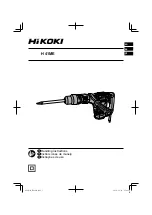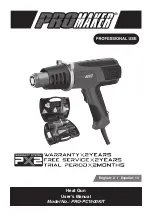
ancorproducts.com | 800.307.6702
11
OPERATOR'S MANUAL:
120V TWO SETTING HEAT GUN
APPLICATIONS
WARNING
Reduce the risk of heat damage and personal injury, shield
combustible materials and areas adjacent to the work piece.
Protect yourself from hot paint scrapings and dust.
SHRINKING TUBING
Shrink tubing is most often used in place of electrical tape to hold joined wires in
position and provide insulation. When exposed to adequate heat, the tubing shrinks to
the size and shape of the wire it covers. Slide the tubing over the wire to be insulated;
hold the wire with one hand away from the hot air stream and hold the heat gun in
the other hand. Move the tubing from side to side through the heated air flow until
the tubing has shrunk. If the wire must be held with both hands, position the heat gun
with the nozzle pointed upward by resting the heat gun on the handle and the rear gun
housing. Then pass the tubing covered wire from side to side through the hot air flow
until the wire shrinks to the desired size. Remove the wire from the air flow and move
the rocker switch to the "OFF" position.
STRIPPING PAINT
1) Fit the wide "deflector" accessory tip on to the heat gun nozzle. This tip will spread
the heat over a wider surface area, speeding paint removal. The "deflector" tip will
also help protect window glass from cracking due to thermal shock when removing
paint near the glass.
2) Turn the heat gun on, starting in the "Low" heat setting and hold it about 1 inch
from the painted surface being stripped. The best combination of distance, heat
range and speed of stripping will be determined by experience.
3) Work small areas, moving the gun slowly over the surface. When the paint begins
to blister and bubble, move the gun steadily across the surface while scraping off
the loosened paint behind the heat gun. Use a scraper that best matches the work
surface shape and width of the paint loosened by the heat gun's path. Preheating
the scraper as you are heating the painted surface will increase the speed of paint
stripping.
4) Do not burn or heat the paint for too long since this will make the paint more
difficult to remove.
For working in confined areas, away from glass, remove the wide deflector tip.
5) When the job is completed, move the rocker switch to "OFF" and properly position
the heat gun to cool, away from combustible material.
MAINTENANCE
CLEANING
Avoid using solvents when cleaning plastic parts. Most plastics are susceptible to
damage from various types of commercial solvents and maybe damaged by their use.
Use clean cloths to remove dirt, dust, oil, grease, etc.






























